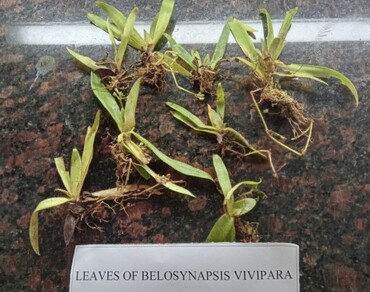Microscopic characterization and proximate analysis of Belosynapsis vivipara leaves: a rare plant of Western Ghats region
*Article not assigned to an issue yet
Research Articles | Published: 15 June, 2025
First Page: 0
Last Page: 0
Views: 228
Keywords: n Belosynapsis viviparan , GC–MS, Microscopy, Proximate analysis, SEM
Abstract
Belosynapsis vivipara (Dalzell) C.E.C. Fisch. (F: Commelinaceae) is distributed throughout Western Ghats regions in India. The plant is not well known in scientific platforms due to lack of availability in all the places in India. The plant was identified and described earlier but its therapeutic activities and other botanical aspects are still in demand. Traditionally, the leaves were established as a potential part for human applications. With that, the aim of the present study was carried out with the microscopic method and SEM analysis for determination of the anatomical arrangement and histological nature of the leaves and various proximate analyses such as moisture content, ash content, extractive values, crude fiber content, crude fat content, protein content and carbohydrate content were also determined. The fresh and dried leaves showed the presence of moisture content of 18.46% and 6.12%, total ash of 4.04% and 9.43%, alcohol-soluble extractives of 15.11% and 18.32%, water-soluble extractives of 11.08% and 15.34%, crude fiber of 8.08% and 11.61%, crude fat of 4.01% and 2.32%, and crude protein of 11.02% and 4.14%, respectively. GCMS study revealed the presence of 25 important bioactive compounds among them, five main compounds were identified and confirmed with the TLC and HPLC analysis, i.e., stigmasterol, beta-sitosterol, lupeol, gallic acid, and squalene. Finally, the overall result concluded that the microscopic analysis, proximate parameters, and bioactive compounds can serve as tools for the development of standards for proper authentication, quality, and purity of Belosynapsis vivipara leaves.

References
Awogbemi O, Ogunleye IO (2009) Effects of drying on the qualities of some selected vegetables. IACSIT Int J Eng Technol 1(5):1793–8236. https://doi.org/10.7763/IJET.2009.V1.77
Baraniak BM, Waleriańczyk E (2003) Flocculation. In: Encyclopedia of Food Sciences and Nutrition (Second Edition), Academic Press, pp. 2531–2535
Broadley MR, White PJ, Hammond JP, Zelko I, Lux A (2007) Zinc in plants. New Phytol 173(4):677–702. https://doi.org/10.1111/J.1469-8137.2007.01996.X
Chaudhari RK, Girase NO (2015) Determination of soluble extractives and physico-chemical studies of bark of Sesbania sesban (L) Merr. J Chem Pharm Res 7(8):657–660
Das K (2019) Pharmacognostical and proximal analysis of two different extracts (methanol and aqueous) of Indian endangered Coscinium fenestratum Stem. Indian J Pharm Educ Res 53(4s):s710–s720. https://doi.org/10.5530/ijper.53.4s.168
Das K, Singirikonda S (2023) Elemental impact on antibacterial study of hydroalcoholic leaves extract of extract of extract of extract of Belosynapsis vivipara. Notulae Scientia Biologicae 15(1): 11409. https://doi.org/10.55779/nsb15111409
Das K, Khan MS, Namratha N, Swetha R, Gezici S (2019) Comparative phytochemical screening, elemental content and chromatographic evaluation for detection and quantification of polyphenolic compounds for strong antioxidant activity of various extracts of Abutilon indicum (Link) Sweet leaves. Ann Phytomed 8(1):36–44. https://doi.org/10.21276/ap.2019.8.1.4
Hardy CR, Stevenson DW (2000) Development of the gametophytes, flower, and floral vasculature in Cochliostema odoratissimum (Commelinaceae). Bot J Linn Soc 134:131–157. https://doi.org/10.1006/bojl.2000.0367
Kaneria M, Chanda S (2011) Phytochemical and pharmacognostic evaluation of leaves of Psidium guajava L. (Myrtaceae). Pharmacog J 3:41–45. https://doi.org/10.5530/pj.2011.23.6
Kavade S, Deokule S, Lakshminarasimhan P, Diwakar P, Punekar S (2012) Belosynapsis vivipara (Dalzell) C.E.C. Fisch. (Commelinaceae), a vulnerable spiderwort, rediscovered after sixteen decades from Maharashtra, India. J Threat Taxa 4(6): 2660–2663. https://doi.org/10.11609/JoTT.o2444.2660-3
Khonsa K, Setyaningrum DL, Saputro AH, Amelia T, Ibrahim S, Damayanti S (2022) Analysis of beta sitosterol in supplement using high performance liquid chromatography: development and validation. Rasayan J Chem 15(3):1997–2003. https://doi.org/10.31788/RJC.2022.1536752
Lu HT, Jiang Y, Chen F (2003) Preparative separation and purification of squalene from the Microalga thraustochytrium ATCC 26185 by high-speed counter-current chromatography. J Chromatogr 994:37–43. https://doi.org/10.1016/S0021-9673(03)00454-0
Orhuamen EO, Olorunmaiye, Stephen K, Adeyemi, Oreoluwa C (2012) Proximate analysis of fresh and dry leaves of Telfairia occidentalis (Hook.f.) and Talinum triangulare (Jacq.) Willd. Croat J Food Technol Biotechnol Nutr 7(3–4): 188–191
Pytlakowska K, Kita A, Janoska P, Połowniak M, Kozik V (2012) Multi-element analysis of mineral and trace elements in medicinal herbs and their infusions. Food Chem 135(2):494–501. https://doi.org/10.1016/j.foodchem.2012.05.002
Samreen T, Humaira SHU, Ullah S, Javid M (2017) Zinc effect on growth rate, chlorophyll, protein and mineral contents of hydroponically grown mungbeans plant (Vigna radiata). Arab J Chem 10(2):S1802–S1807. https://doi.org/10.1016/j.arabjc.2013.07.005
Sasane NA, Gaikar PS, Gaikwad SL, Valvi AK, Wadhawa GC (2021) Phytochemical analysis, anti-oxidant and anti-inflammatory of Belosynapsis vivipara leaves and roots. Int J Bot Stud 6(4):138–142
Sharma V, Pracheta P (2013) Microscopic studies and preliminary pharmacognostical evaluation of Euphorbia neriifolia L. leaves. Indian J Nat Prod Resour 4:348–357
Slavin JL (2005) Dietary fiber and body weight. Nutrition 21:411–418. https://doi.org/10.1016/j.nut.2004.08.018
Sultana S (2020) Nutritional and functional properties of Moringa oleifera. Metabol Open 8:100061. https://doi.org/10.1016/j.metop.2020.100061
Vaidya VV, Pradhan PM, Shinde MA (2017) High performance liquid chromatography method for simultaneous quantification of oleanolic acid, lupeol and β-sitosterol from nyctanthes arbor-tristis and its marketed formulation. Int J Res Pharm Chem 7(4):387–393
Yadilal G, Manisha M, Pavani E, Navya M, Alekhya C, Chandini GH, Madhu C (2017) Estimation of crude fiber content in spices and fruits. Indo Am J Pharm Sci 4(10):3864–3868
Author Information
Department of Pharmacognosy and Phytochemistry, Mallige College of Pharmacy, Bengaluru, India